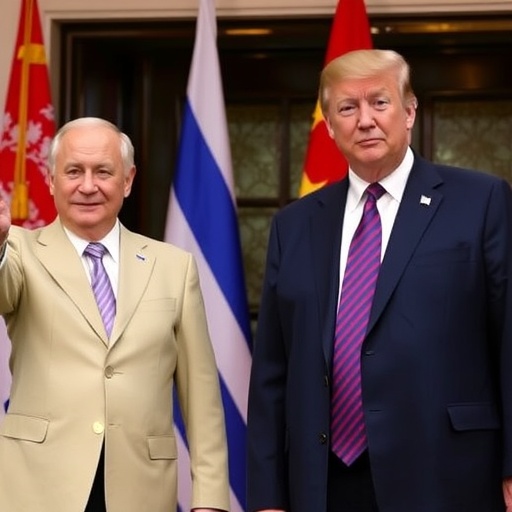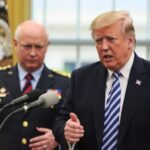Trump Enlists China’s Support for Russia Peace Deal on Pivotal Asia Trip Amid Ukraine Crisis
In a bold diplomatic maneuver, President Donald Trump has publicly called on China to play a pivotal role in brokering a peace deal with Russia over the ongoing Ukraine war, as he launches a high-stakes five-day Asia trip aimed at reshaping global security dynamics. Speaking from the White House before departing for the region, Trump emphasized that Beijing’s involvement could be the ‘key to unlocking peace,’ highlighting the urgency of collective action in the face of escalating tensions.
- Trump’s Urgent Call to Beijing: A Game-Changer in Russia Negotiations
- Unveiling the Asia Trip Itinerary: From Tokyo Talks to Manila Summits
- Escalating Ukraine War Pressures Fuel Trump’s Diplomatic Gambit
- International Voices React to China’s Potential Role in Peace Talks
- Pathways to Peace: What a China-Backed Deal Could Mean for Global Stability
This unexpected outreach comes at a critical juncture, with the Ukraine conflict entering its third year and causing widespread humanitarian and economic fallout. Trump’s Asia trip, which includes stops in Japan, South Korea, and the Philippines, is not just about bilateral ties but a strategic push to rally Asian powers against Russian aggression, while subtly addressing China’s growing influence in the Indo-Pacific.
Trump’s Urgent Call to Beijing: A Game-Changer in Russia Negotiations
President Trump’s direct appeal to China marks a significant shift in U.S. foreign policy toward the Ukraine crisis. During a press briefing on Monday, Trump stated, ‘China has the leverage and the wisdom to help end this senseless war. We’ve got to bring them to the table with Russia for a real peace deal.’ This comes as U.S. intelligence reports indicate that Chinese economic ties with Russia have deepened since the invasion began in February 2022, with bilateral trade surging to over $240 billion in 2023, according to data from the Chinese General Administration of Customs.
The call for Chinese involvement isn’t without precedent. Beijing has positioned itself as a neutral mediator in global conflicts, notably brokering a 2023 deal between Iran and Saudi Arabia. However, experts note that China’s reluctance to criticize Russia’s actions stems from shared strategic interests, including opposition to U.S.-led sanctions. Trump’s strategy appears to leverage this neutrality, offering economic incentives like eased trade restrictions in exchange for diplomatic pressure on Moscow.
Under the current administration, Trump has pursued a ‘maximum pressure’ approach on Russia, imposing additional sanctions that have frozen over $300 billion in Russian central bank assets abroad. Yet, with military aid to Ukraine totaling $61 billion since 2022, fatigue is setting in among allies. Incorporating China could diversify negotiation channels, potentially leading to a ceasefire framework that addresses territorial disputes in eastern Ukraine, where Russian forces control approximately 18% of the country, per the Institute for the Study of War.
Critics, including some Democratic lawmakers, argue that inviting China risks legitimizing its support for Russia. Senator Lindsey Graham, a vocal Trump supporter, countered in a recent interview, ‘This is pragmatic diplomacy. China’s the only power that can talk sense into Putin without firing a shot.’ The move underscores Trump’s transactional style, prioritizing outcomes over ideology.
Unveiling the Asia Trip Itinerary: From Tokyo Talks to Manila Summits
Trump’s five-day Asia trip, kicking off on Tuesday, is meticulously planned to weave the Russia peace deal into broader regional security discussions. The itinerary begins in Tokyo, where Trump will meet Japanese Prime Minister Fumio Kishida to reinforce the U.S.-Japan alliance, strained by recent North Korean missile tests that flew over Japanese airspace 12 times in the past year alone, according to Japan’s Defense Ministry.
From there, the presidential entourage heads to Seoul for consultations with South Korean President Yoon Suk-yeol. Here, the focus will sharpen on China’s role, as South Korea grapples with its own economic dependencies on Beijing—China accounts for 25% of South Korea’s exports. Trump is expected to propose a trilateral framework involving the U.S., Japan, and South Korea to monitor Russian naval activities in the Sea of Japan, which have increased by 40% since 2022, per U.S. Indo-Pacific Command reports.
The trip culminates in Manila, where Trump will address the Association of Southeast Asian Nations (ASEAN) forum. The Philippines, a key U.S. treaty ally, has seen heightened tensions in the South China Sea, with Chinese vessels encroaching on Philippine waters over 200 times in 2023, as documented by the Philippine Coast Guard. Trump’s agenda includes pushing for ASEAN unity on the Ukraine issue, potentially tying it to countering Chinese assertiveness. A White House official, speaking anonymously, revealed that side meetings with Chinese diplomats are under consideration, though unconfirmed.
This tour builds on Trump’s previous Asia engagements, where he secured $200 billion in trade deals during his first term. Economically, the trip could yield investments in semiconductor supply chains, vital as Asia produces 75% of the world’s chips, amid U.S. efforts to reduce reliance on China through the CHIPS Act, which has allocated $52 billion since 2022.
- Key Stops: Tokyo (Days 1-2): Alliance reinforcement and Russia briefings.
- Seoul (Day 3): Trilateral security pacts and China outreach.
- Manila (Days 4-5): ASEAN diplomacy and South China Sea resolutions.
The logistical scale is immense, involving Air Force One, a delegation of 150 aides, and security protocols that rival Olympic events, all while navigating Asia’s humid summer climate and potential protests over U.S. tariff policies.
Escalating Ukraine War Pressures Fuel Trump’s Diplomatic Gambit
The backdrop to Trump’s Asia trip is the unrelenting Ukraine war, which has claimed over 500,000 lives on both sides, according to estimates from the United Nations and Ukrainian officials. Russian advances in the Donbas region have captured key cities like Avdiivka in early 2024, displacing 6.5 million Ukrainians and creating the largest refugee crisis in Europe since World War II.
Economically, the conflict has driven global energy prices up 30% since 2021, with Europe particularly hard-hit—Germany’s inflation peaked at 8.8% in 2022 due to lost Russian gas supplies. Trump’s push for a peace deal aligns with his campaign promises to end ‘forever wars,’ echoing his 2018 Singapore summit with North Korea. Yet, the Russia-Ukraine stalemate persists, with Putin rejecting direct talks unless NATO expansion halts, a non-starter for Kyiv.
China’s potential mediation could address sticking points like Crimea’s status, annexed by Russia in 2014 but unrecognized internationally. Beijing’s ‘no-limits’ partnership with Moscow, declared in February 2022, includes supplying dual-use technologies like drone components, which the U.S. has sanctioned under export controls affecting 100 Chinese firms.
Domestic U.S. politics add urgency: With midterm elections looming, Trump’s approval on foreign policy hovers at 45%, per Gallup polls. A successful peace initiative could bolster his image, especially as 62% of Americans support diplomatic solutions over prolonged aid, according to a Pew Research survey from March 2024.
- Russian troop deployments: Over 600,000 soldiers committed, per NATO estimates.
- Ukrainian resilience: Holding 82% of territory with Western arms like HIMARS systems.
- Global ripple effects: Food prices up 20% worldwide due to blocked Black Sea exports.
Trump’s team has prepared contingency plans, including virtual summits if in-person China talks falter, emphasizing the trip’s role in preventing broader escalation.
International Voices React to China’s Potential Role in Peace Talks
Global reactions to Trump’s overture to China are mixed, with allies expressing cautious optimism and adversaries decrying it as weakness. European Union foreign policy chief Josep Borrell tweeted, ‘Any path to peace must include all stakeholders, but China’s neutrality is questionable given its trade with Russia.’ Meanwhile, NATO Secretary General Jens Stoltenberg welcomed multilateral efforts, noting in a Brussels presser that ‘diplomacy is our strongest weapon.’
In Asia, responses vary. Indian Prime Minister Narendra Modi, who has abstained from UN votes condemning Russia, praised the initiative as ‘forward-thinking,’ reflecting New Delhi’s balancing act—India imports 40% of its oil from Russia at discounted rates. Conversely, Australian Prime Minister Anthony Albanese voiced concerns over China’s human rights record, linking it to Ukraine mediation credibility.
Russian officials dismissed the proposal initially, with Kremlin spokesperson Dmitry Peskov stating, ‘We negotiate on our terms, not Washington’s.’ Yet, backchannel talks suggest Moscow might entertain Chinese involvement to ease sanctions biting its economy, which shrank 2.1% in 2022 before rebounding modestly.
Ukrainian President Volodymyr Zelenskyy, in a video address, urged caution: ‘China must prove its commitment to sovereignty, not just words.’ His stance highlights Kyiv’s wariness, having received $175 billion in international aid, with the U.S. contributing the lion’s share.
Think tanks like the Brookings Institution analyze this as a ‘high-risk, high-reward’ strategy. Analyst Fiona Hill noted in a recent op-ed, ‘Trump’s Asia trip could redefine alliances, but alienating Europe in the process would be disastrous.’ Public opinion in China, via state media like Xinhua, portrays the U.S. appeal as an acknowledgment of Beijing’s rising power, boosting national pride amid domestic economic slowdowns.
The diplomatic ripple extends to the UN Security Council, where China and Russia hold veto power, stalling resolutions on Ukraine. Trump’s move might prompt a special session, potentially involving G20 leaders who convene in November 2024.
Pathways to Peace: What a China-Backed Deal Could Mean for Global Stability
Looking ahead, a successful integration of China into Russia peace negotiations could reshape the geopolitical landscape. Analysts predict a phased approach: First, a humanitarian ceasefire to allow grain exports from Odessa, stabilizing food markets that have affected 2.4 billion people in developing nations, per World Bank data. Second, territorial talks mediated by China could freeze frontlines, with economic reconstruction funded by unfrozen Russian assets.
For the Asia trip, outcomes might include joint U.S.-China statements on non-interference, extending to Taiwan tensions where Beijing’s military drills have intensified, with 125 warplanes crossing the median line in 2023. Trump’s delegation carries proposals for tech collaborations, like AI ethics pacts, to build trust.
Challenges remain: Internal Chinese politics, with President Xi Jinping prioritizing domestic stability amid 5% GDP growth targets, could delay commitments. Moreover, U.S. congressional hawks like Senator Marco Rubio warn of espionage risks in deeper engagements.
Ultimately, this initiative signals a multipolar world order, where Asia’s economic heft—projected to reach 50% of global GDP by 2030, according to IMF forecasts—dictates peace terms. As Trump departs, the world watches whether his Asia trip will forge a lasting Russia peace deal or expose fractures in the international alliance against aggression. Next steps include follow-up summits in Geneva, potentially by fall 2024, to translate rhetoric into reality.









